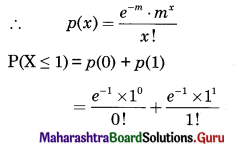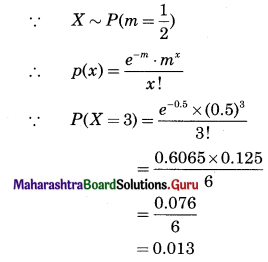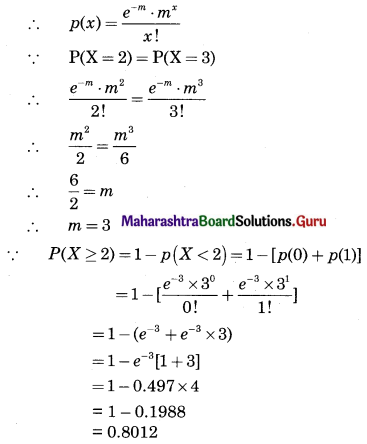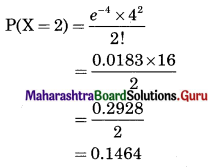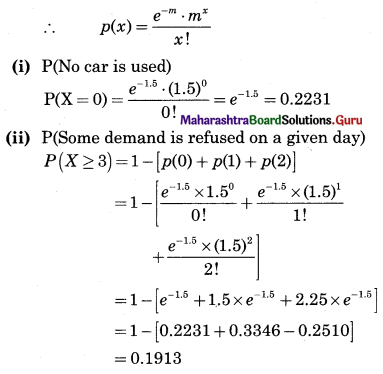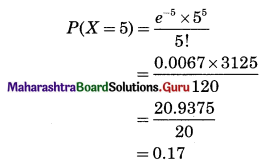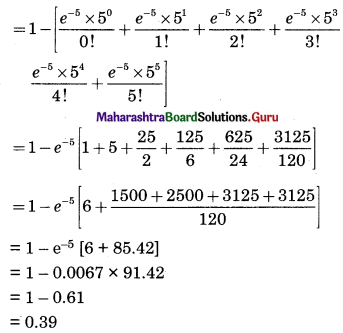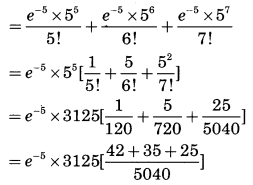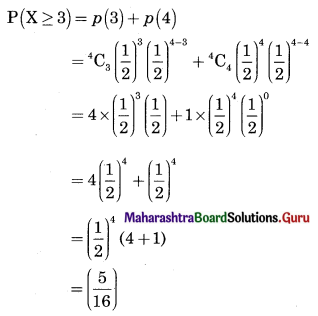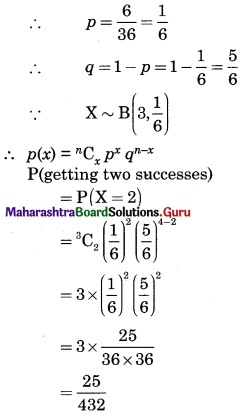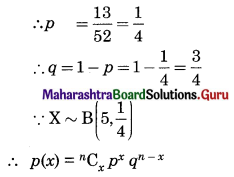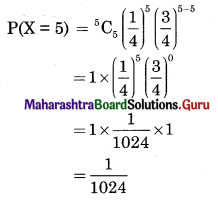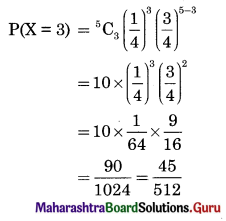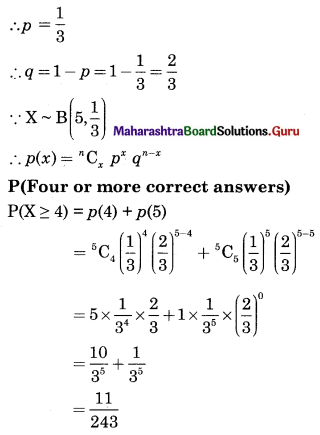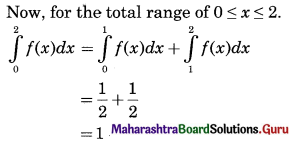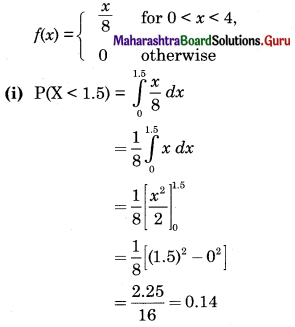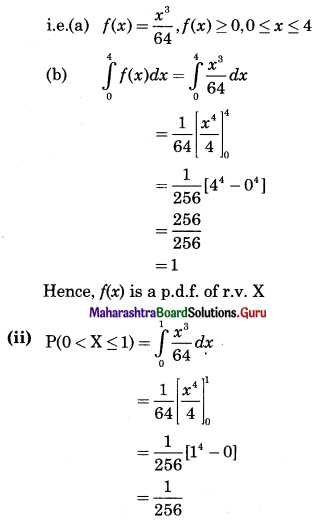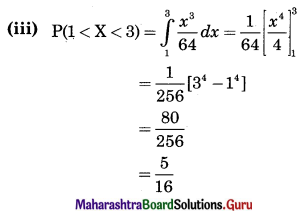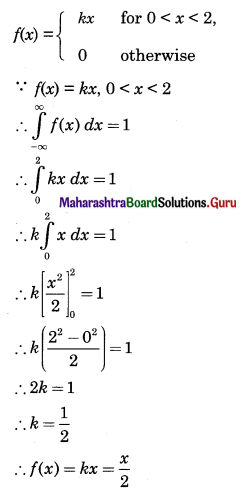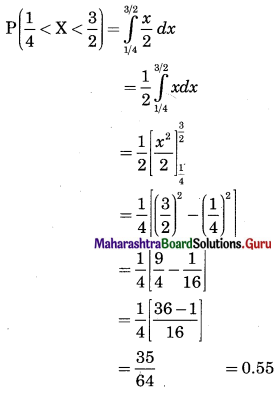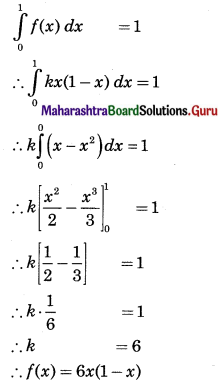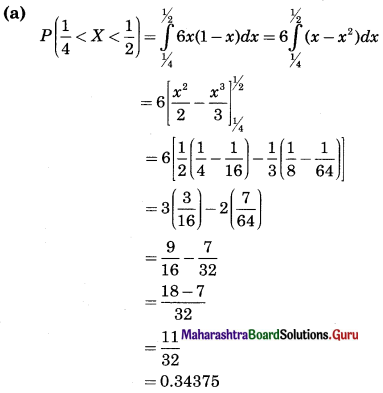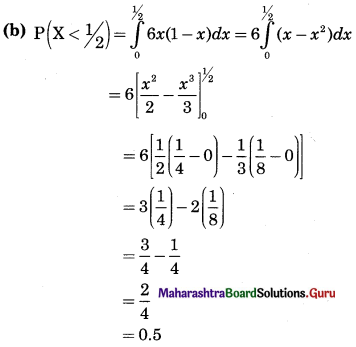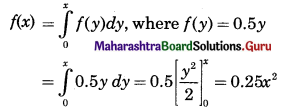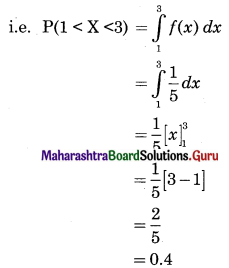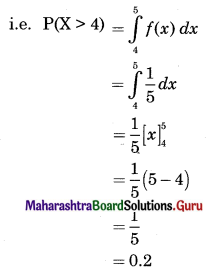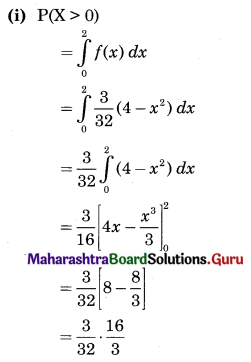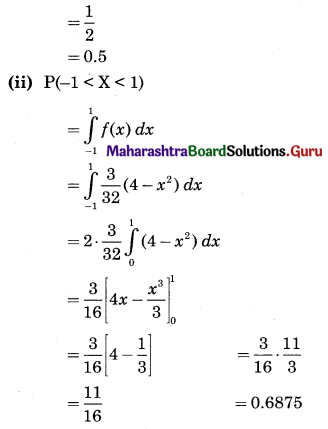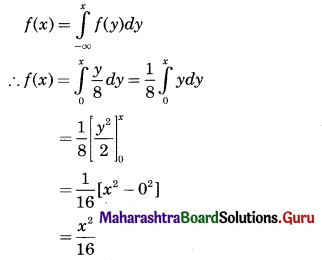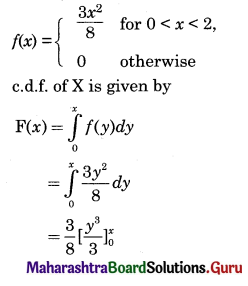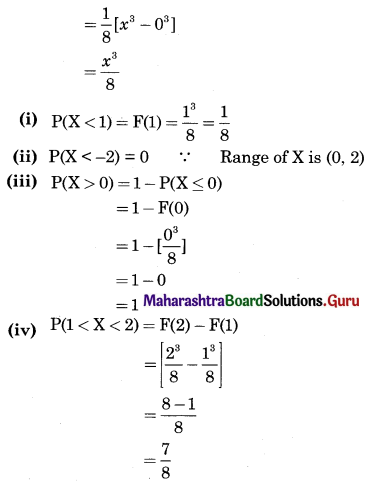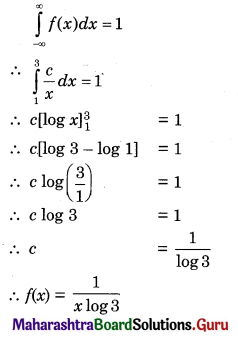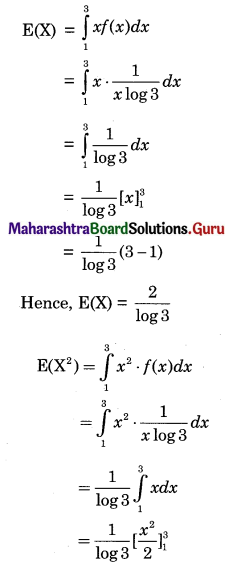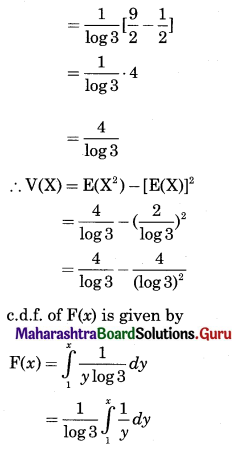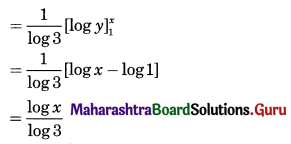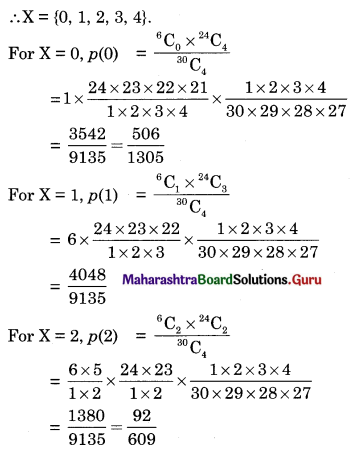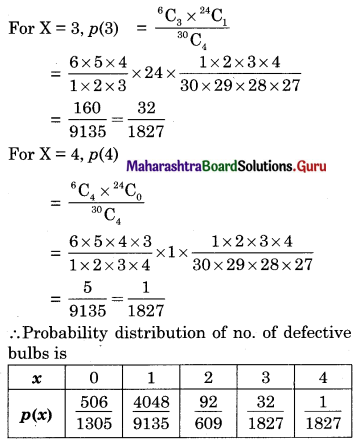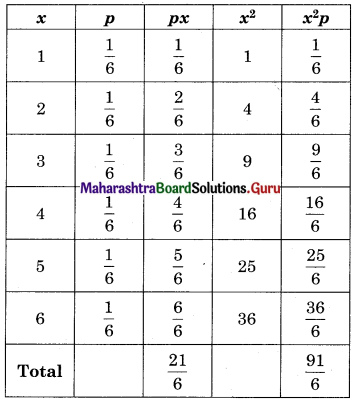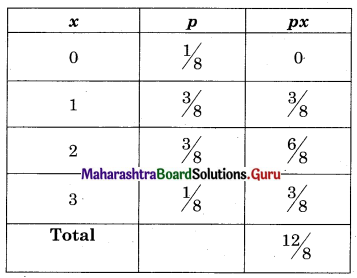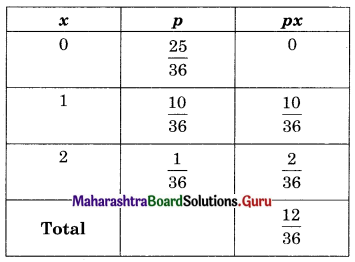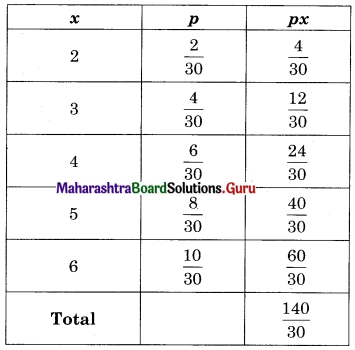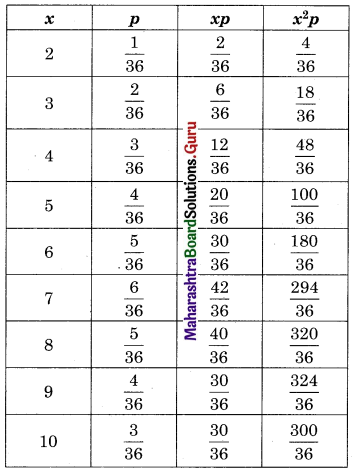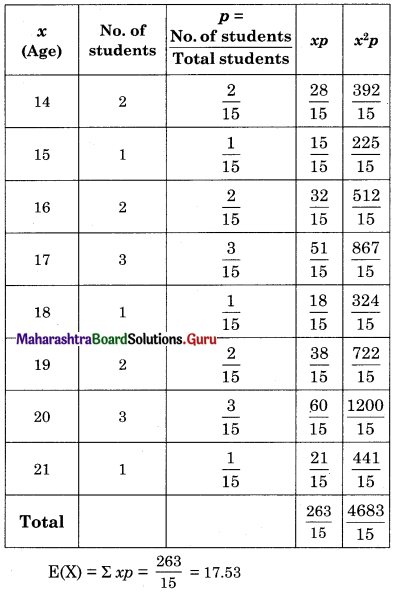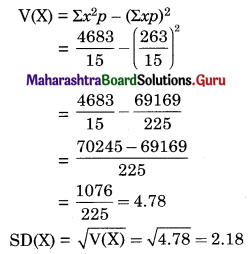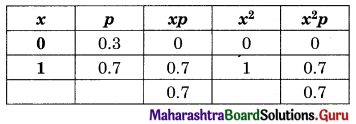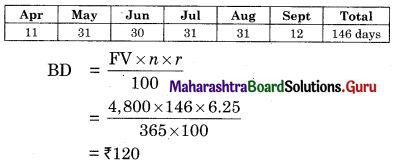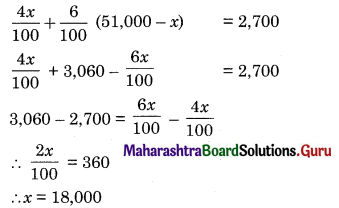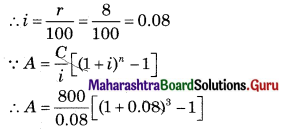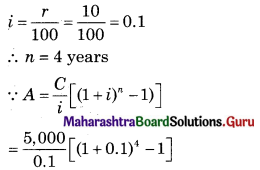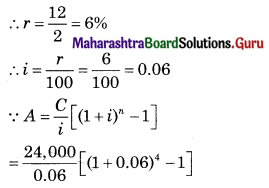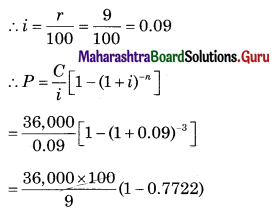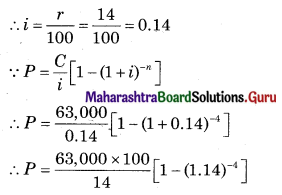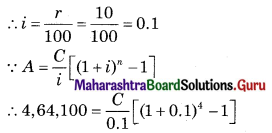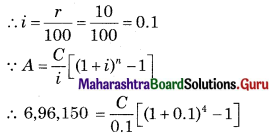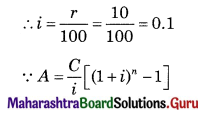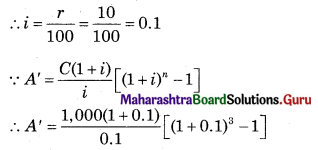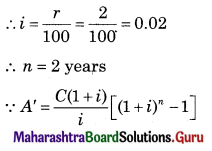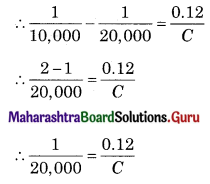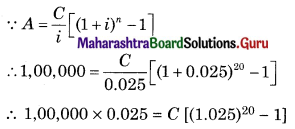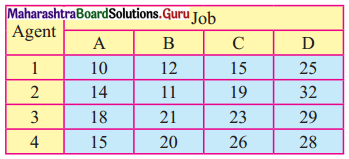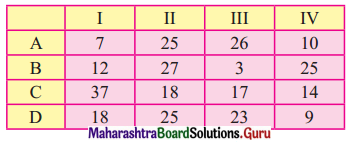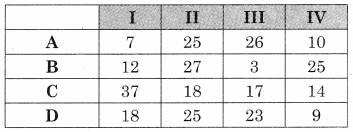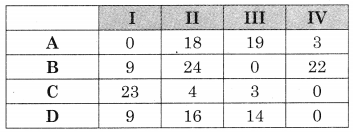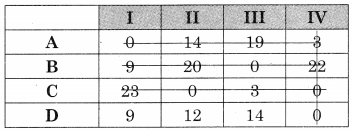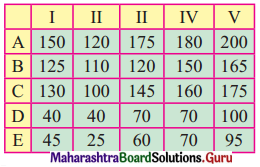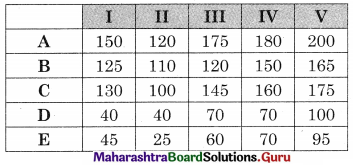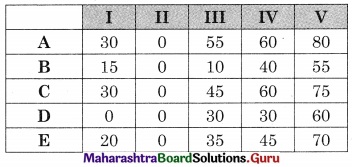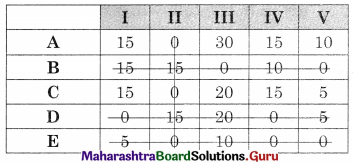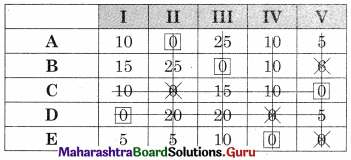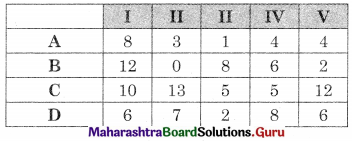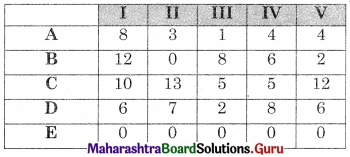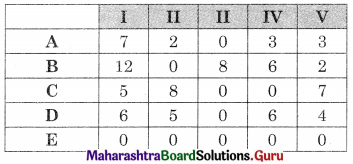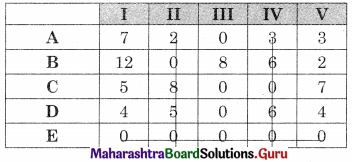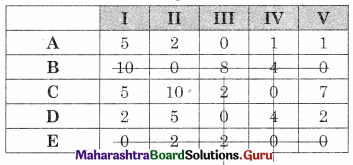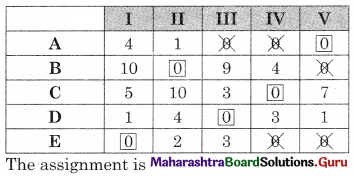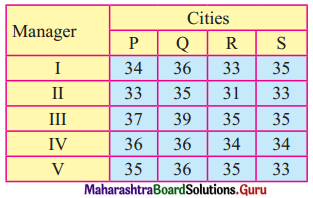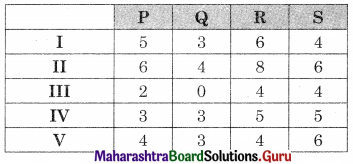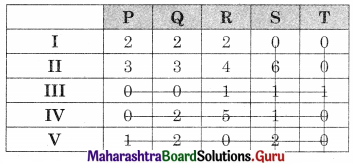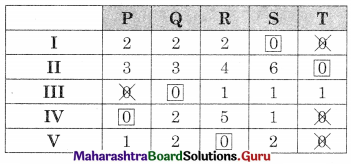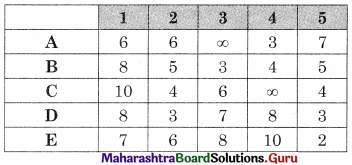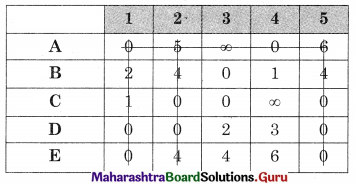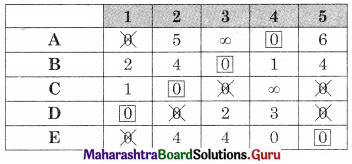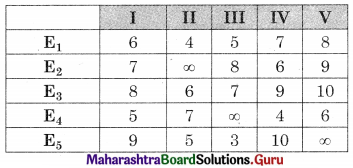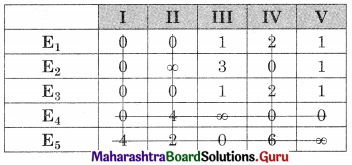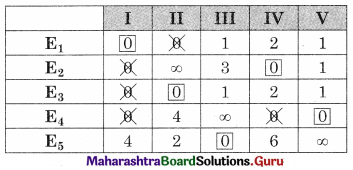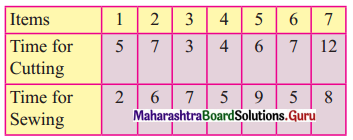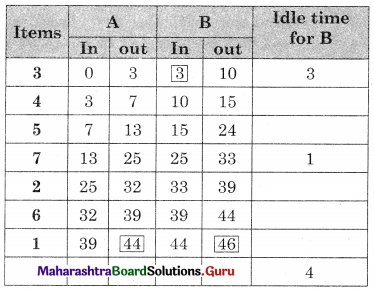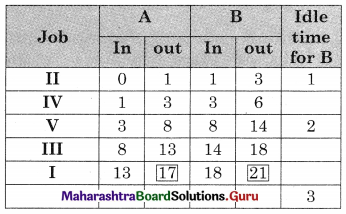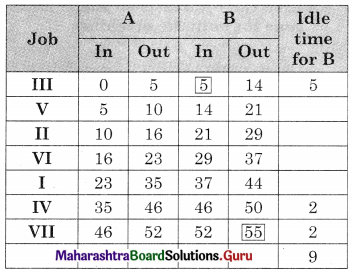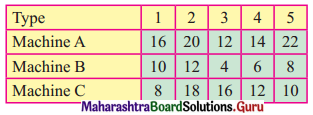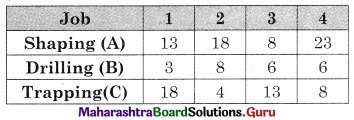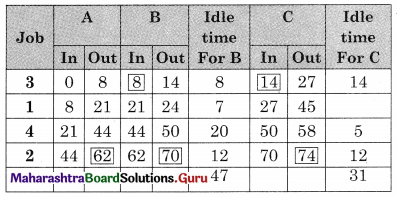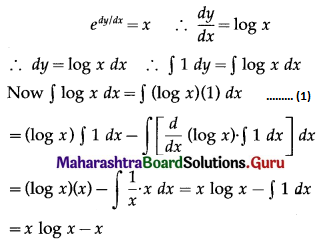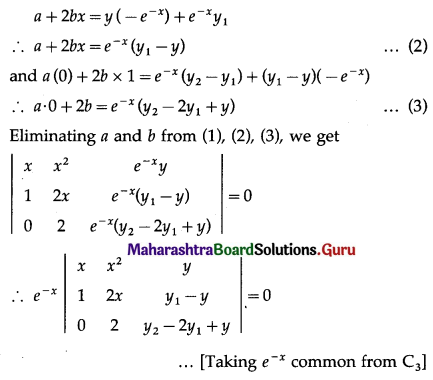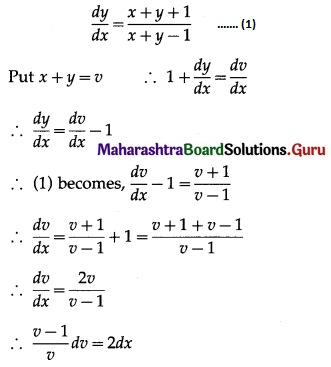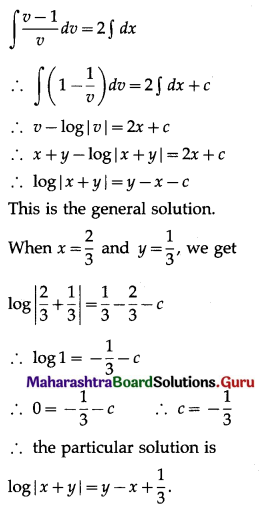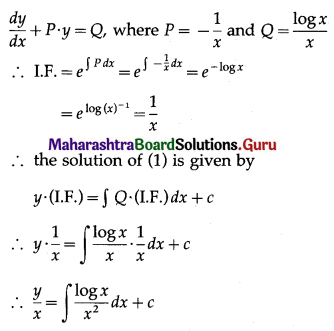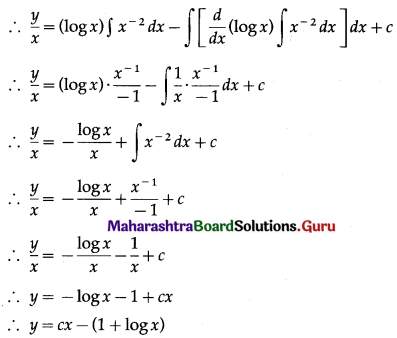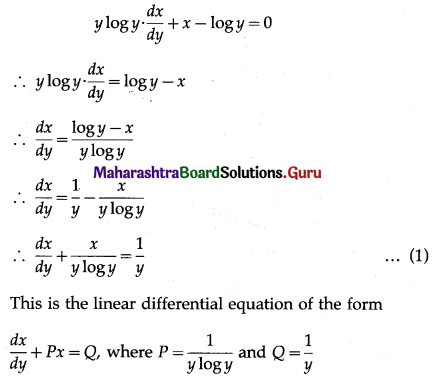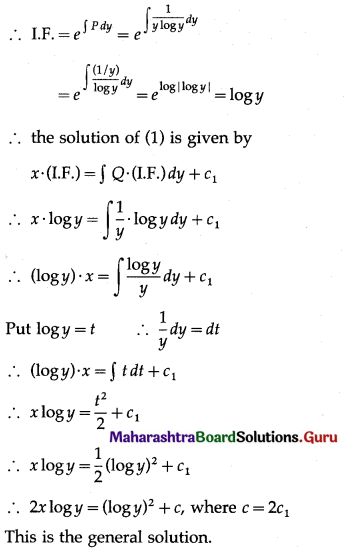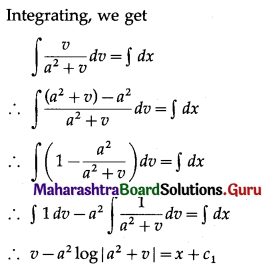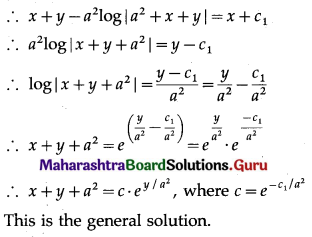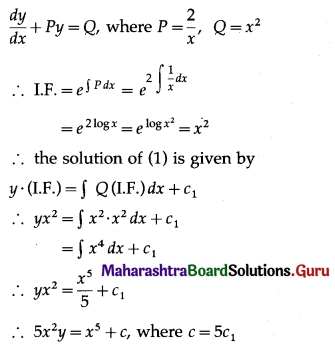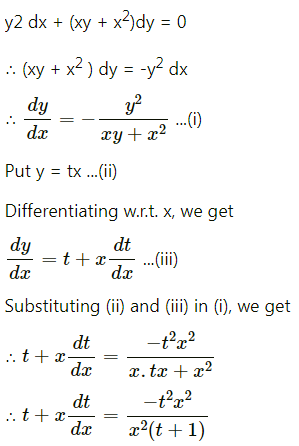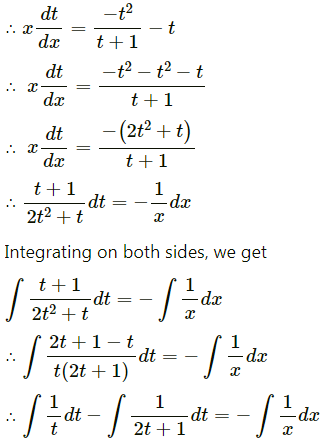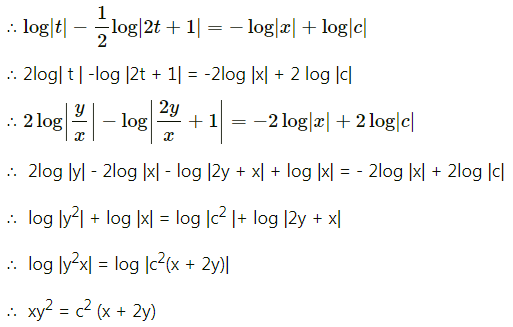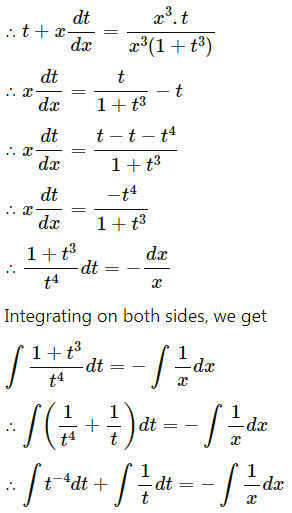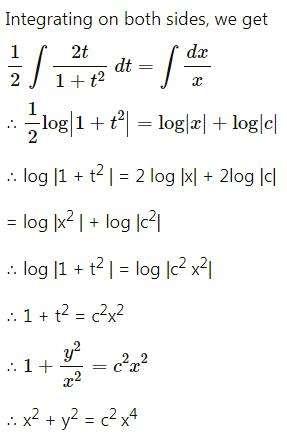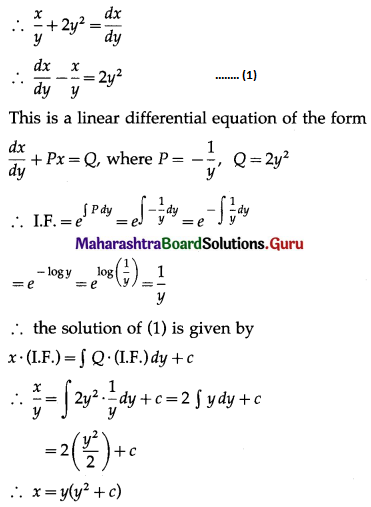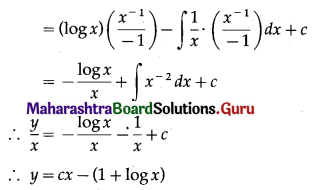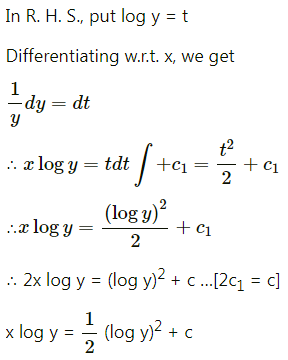Balbharati Maharashtra State Board 12th Commerce Maths Digest Pdf Chapter 1 Commission, Brokerage and Discount Ex 1.1 Questions and Answers.
Maharashtra State Board 12th Commerce Maths Solutions Chapter 1 Commission, Brokerage and Discount Ex 1.1
Question 1.
An agent charges a 12% commission on the sales. What does he earn if the total sale amounts to ₹ 48,000? What does the seller get?
Solution:
Rate of commission = 12%
Total sales = ₹ 48,000
Agent’s commission = \(\frac {12}{100}\) × 48,000
= ₹ 5,760
Amount received by the seller = Total sales – commission
= ₹ 8,000 – ₹ 5760
= ₹ 2,240
Question 2.
A salesman receives a 3% commission on sales up to ₹ 50,000 and a 4% commission on sales over ₹ 50,000. Find his total income on the sale of ₹ 2,00,000.
Solution:
Total sales = ₹ 2,00,000
Rate of commission upto ₹ 50,000 = 3%
= \(\frac{3}{100}\) × 50,000
= ₹ 1,500
Rate of commission on the sales over ₹ 50,000 = 4%
Sales over ₹ 50,000 is 2,00,000 – 50,000 = ₹ 1,50,000
Commission on sales over ₹ 50,000 = \(\frac{4}{100}\) × 1,50,000 = ₹ 6,000
His total income = ₹ 1,500 + ₹ 6,000 = ₹ 7,500
![]()
Question 3.
Ms. Saraswati was paid ₹ 88,000 as commission on the sale of computers at the rate of 12.5%. If the price of each computer was ₹ 32,000, how many computers did she sell?
Solution:
Total commission = ₹ 88,000
Rate of commission = 12.5%
Let the number of computers sold be x
since price of each computer = ₹ 32,000
Total sales = ₹ 32,000x
Total commission = 12.5% of total sales
88,000 = \(\frac{12.5}{100}\) × 32,000x
= \(\frac{125}{1000}\) × 32,000x
x = \(\frac{88,000}{125 \times 32}\)
x = 22
Question 4.
Anita is allowed 6.5% commission on the total sales made by her, plus, a bonus of \(\frac{1}{2}\)% on the sale over ₹ 20,000. If her total commission amounts to ₹ 3,400. Find the sales made by her.
Solution:
Let the total sales made by Anita be ₹ x
Rate of commission = 6.5% of total sales
= \(\frac{6.5}{100} \times x\)
= \(\frac{65 x}{1,000}\)
= \(\frac{13 x}{200}\)
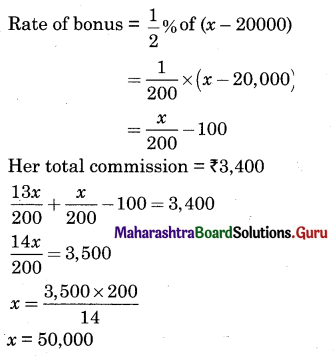
Question 5.
Priya gets a salary of ₹ 15,000 per month and a commission of 8% on sales over ₹ 50,000. If she gets ₹ 17,400 in a certain month. Find the sales made by her in that month.
Solution:
Let the total sales made by Priya be ₹ x
Salary of Priya = ₹ 15,000
Commission = Total earning – salary
= ₹ 17,400 – ₹ 15,000
= ₹ 2,400
Commission = 8% on the sales over ₹ 50,000
2400 = \(\frac{8}{100}\) (x – 50000)
\(\frac{2,400 \times 100}{8}\) = x – 50,000
30,000 = x – 50,000
30,000 + 50,000 = x
∴ x = ₹ 80,000
![]()
Question 6.
The income of the broker remains unchanged though the rate of commission is increased from 4% to 5%. Find the percentage reduction in the value of the business.
Solution:
Let the original value of business be ₹ 100
Original rate of commission = 4%
∴ Original commission = \(\frac{4}{100}\) × 100 = ₹ 4
Let the new value of business be ₹ x
The new rate of commission = 5%
∴ New commission = \(\frac{5}{100}\) × x = \(\frac{x}{20}\)
Given, original income = New income
4 = \(\frac{x}{20}\)
∴ x = ₹ 80
Thus there is 20% reduction in the value of the business.
Question 7.
Mr. Pavan is paid a fixed weekly salary plus commission based on a percentage of sales made by him. If on the sale of ₹ 68,000 and ₹ 73,000 in two successive weeks, he received in all ₹ 9,880 and ₹ 10,180. Find his weekly salary and the rate of commission paid to him.
Solution:
Let the weekly salary of Mr. Pavan be ₹ x and the rate of commission paid to him be y%
Income = Weekly salary + Commission on the sales
∴ 9,880 = x + \(\frac{y}{100}\) × 68,000
i.e. 9,880 = x + 680y …….(1)
Also, 10,180 = x + \(\frac{y}{100}\) × 73,000
i.e 10,180 = x + 730y ………(2)
Subtracting (1) from (2), we get
50y = 300
∴ y = 6
Substituting y = 6 in equation (1)
9,880 = x + 680(6) ‘
∴ 9,880 – 4,080 = x
∴ x = 5,800
Weekly salary = ₹ 5,800
Rate of commission = 6%
Question 8.
Deepak’s salary was increased from ₹ 4,000 to ₹ 5,000. The sales being the same, due to a reduction in the rate of commission from 3% to 2%, his income remained unchanged. Find his sales.
Solution:
Let Deepak’s total sales be ₹ x
Original salary of Deepak = ₹ 4,000
Original rate of commission = 3%
His new salary = ₹ 5,000
New rate of commission = 2%
Original income = New income (given)
4000 + \(\frac{3 x}{100}\) = 5000 + \(\frac{2 x}{100}\)
\(\frac{3 x}{100}-\frac{2 x}{100}\) = 5,000 – 4,000
\(\frac{x}{100}\) = 1000
x = ₹ 1,00,000
∴ His total sales = ₹ 1,00,000
![]()
Question 9.
An agent is paid a commission of 7% on cash sales and 5% on credit sales made by him. If on the sale of ₹ 1,02,000 the agent claims a total commission of ₹ 6,420, find his cash sales and credit sales.
Solution:
Total Sales = ₹ 1,02,000
Let cash sales ₹ x
∴ Credit sales = ₹ (1,02,000 – x)
Agent’s commission on cash sales = 7%
= \(\frac{7}{100}\) × x
= \(\frac{7x}{100}\)
Commission on credit sales = 5%
= \(\frac{5}{100}\)(1,02,000 – x)
Given, Total commission = ₹ 6,420
∴ \(\frac{7x}{100}\) + \(\frac{5}{100}\)(1,02,000 – x) = 6420
∴ \(\frac{7x}{100}\) + 5100 – \(\frac{5x}{100}\) = 6,420
∴ \(\frac{2x}{100}\) = 6,420 – 5,100
∴ \(\frac{2x}{100}\) = 1320
∴ x = ₹ 66,000
∴ Cash sales = ₹ 66,000
∴ Credit sales = 1,02000 – 66,000 = ₹ 36,000
Question 10.
Three cars were sold through an agent for ₹ 2,40,000, ₹ 2,22,000 and ₹ 2,25,000 respectively. The rates of the commission were 17.5% on the first, 12.5% on the second. If the agent overall received 14% commission on the total sales, find the rate of commission paid on the third car.
Solution:
Total selling price of three cars = 2,40,000 + 2,22,000 + 2,25,000 = ₹ 6,87,000
Commission on total sales = 14%
= \(\frac{14}{100}\) × 6,87,000
= ₹ 96,180
Selling price of first car = ₹ 2,40,000
Rate of commission = 17.5% = \(\frac{17.5}{100}\) × 2,40,000
∴ Commission on first car = ₹ 42,000
Selling price of second car = ₹ 2,22,000
Rate of commission = 12.5% = \(\frac{12.5}{100}\) × 2,22,000
∴ Commission on second car = ₹ 27,750
Selling price of third car = ₹ 2,25,000
Let the rate of commission be x%
Commission on third car = \(\frac{x}{100}\) × 2,25,000
96,180 – (42,000 + 27,750) = \(\frac{x}{100}\) × 2,25,000
\(\frac{26,430 \times 100}{2,25,000}\) = x
∴ x = 11.75
∴ Rate of commission on the third car = 11.75%
Question 11.
Swatantra Distributors allows a 15% discount on the list price of the washing machines. Further 5% discount is giver for cash payment. Find the list price of the washing machine if it was sold for the net amount of ₹ 38,356.25.
Solution:
Let the list price of the washing machine be ₹ 100
Trade discount = 15% = \(\frac{15}{100}\) × 100 = ₹ 15
∴ Invoice price =100 – 15 = ₹ 85
Cash discount = 5% = \(\frac{5}{100}\) × 85 = ₹ 4.25
∴ Net price = 85 – 4.25 = ₹ 80.75
Thus if List price is 100 than Net price is 80.75
if List price is x than Net price is 38,356.25.
∴ x = \(\frac{38356.25 \times 100}{80.75}\)
∴ x = ₹ 47,500
The list price of the washing machine is ₹ 47,500
![]()
Question 12.
A bookseller received ₹ 1,530 as a 15% commission on the list price. Find the list price of the books.
Solution:
Let the list price of the books be ₹ x
Rate of commission = 15%
Book seller’s commission = ₹ 1,530
∴ \(\frac{15}{100}\) × x = 1,530
∴ x = \(\frac{1,530 \times 100}{15}\)
∴ x = ₹ 10,200
Question 13.
A retailer sold a suit for ₹ 8,832 after allowing an 8% discount on market price and a further 4% cash discount. If he made 38% profit, find the cost price and the market price of the suit.
Solution:
Let the marked price of the suit be ₹ 100
Trade discount = 8% = \(\frac{8}{100}\) × 100 = ₹ 8
Invoice price = 100 – 8 = ₹ 92
Cash discount = 4% = \(\frac{4}{100}\) × 92 = ₹ 3.68
∴ Net price = 92 – 3.68 = ₹ 88.32
Thus if list price is 100 then net price is 88.32, if list price is x then net price is 8,832
∴ x = \(\frac{8,832 \times 100}{88.32}\)
∴ x = ₹ 10,000
The retailer made 38% profit.
Let the CP of the suit be ₹ 100
∴ SP of the suit = 100 + 38 = ₹ 138
Thus if the SP of the suit is ₹ 138 then its CP is ₹ 100
If the SP of the suit is 88.32 then its
CP = \(\frac{88.32 \times 100}{138}\) = ₹ 6400
Question 14.
An agent charges 10% commission plus 2% delcredere. If he sells goods worth ₹ 37,200, find his total earnings.
Solution:
Total sales = ₹ 37,200
Rate of commission = 10%
Agents commission = \(\frac{4}{100}\) × 37200 = ₹ 3720
Rate of delcredere = 2%
Amount of delcredere = \(\frac{2}{100}\) × 37,200 = ₹ 744
Total earning of the agent = ₹ 3,720 + ₹ 744 = ₹ 4,464
![]()
Question 15.
A whole seller allows a 25% trade discount and 5% cash discount. What will be the net price of an article marked at ₹ 1600?
Solution:
Marked price of the article = ₹ 1,600
Trade discount = 25%
= \(\frac{25}{100}\) × 1,600
= ₹ 400
∴ Invoice price = 1,600 – 400 = ₹ 1,200
Cash discount = 5%
= \(\frac{5}{100}\) × 1,200
= ₹ 60
∴ Net price = 1,200 – 60 = ₹ 1,140
